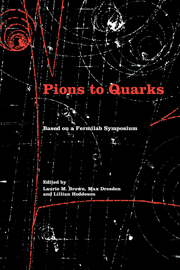Book contents
- Frontmatter
- Contents
- List of contributors
- Foreword by Leon M. Lederman
- Editors' acknowledgments
- Photographs of the symposium
- List of abbreviations
- List of notation
- I Introduction
- II Particle discoveries in cosmic rays
- 4 Cosmic-ray cloud-chamber contributions to the discovery of the strange particles in the decade 1947–1957
- 5 Cosmic-ray work with emulsions in the 1940s and 1950s
- III High-energy nuclear physics
- IV The new laboratory
- V The strange particles
- VI Weak interactions
- VII Weak interactions and parity nonconservation
- VIII The particle physics community
- IX Theories of hadrons
- X Personal overviews
- Name index
- Subject index
4 - Cosmic-ray cloud-chamber contributions to the discovery of the strange particles in the decade 1947–1957
Published online by Cambridge University Press: 07 May 2010
- Frontmatter
- Contents
- List of contributors
- Foreword by Leon M. Lederman
- Editors' acknowledgments
- Photographs of the symposium
- List of abbreviations
- List of notation
- I Introduction
- II Particle discoveries in cosmic rays
- 4 Cosmic-ray cloud-chamber contributions to the discovery of the strange particles in the decade 1947–1957
- 5 Cosmic-ray work with emulsions in the 1940s and 1950s
- III High-energy nuclear physics
- IV The new laboratory
- V The strange particles
- VI Weak interactions
- VII Weak interactions and parity nonconservation
- VIII The particle physics community
- IX Theories of hadrons
- X Personal overviews
- Name index
- Subject index
Summary
Introduction
This chapter is a personal account of the most significant contributions by cosmic-ray physicists to the discovery and study of the strange particles in the ten years that followed the discovery in 1947 of the V particles in conventional cloud chambers. [V particle is a generic term invented by Patrick M. S. Blackett and Carl D. Anderson, and generally adopted in the early days, to describe the strange particles whose decay resulted in characteristic V-shaped tracks (see Figures 4.4, 4.9, and 4.10).] For fuller accounts of the subject, one should see the many excellent reviews in Progress in Cosmic Ray Physics, Progress in Physics, supplements to Il Nuovo Cimento, and Reviews of Modern Physics, and in numerous papers in the proceedings of cosmic-ray and particle physics conferences. Two long historical reviews by Charles Peyrou and myself give the main references.
Significant factors in the discovery of the strange particles in cloud chambers
Two special factors contributed to the success achieved with cloud chambers in the discovery and investigation of strange particles and, in certain areas, made their contribution unique, namely, penetrating-shower selection and counter control.
Penetrating-shower selection
Historically, the V particle work grew out of the detailed study of the so-called penetrating showers (ps) by Lajos Jánossy and his associates before and during the war. To Jánossy, such a shower meant a shower of penetrating particles (i.e., muons), but we now know that it was simply a high-energy interaction consisting mainly of nucleons, pions, muons, electrons, and photons.
- Type
- Chapter
- Information
- Pions to QuarksParticle Physics in the 1950s, pp. 57 - 88Publisher: Cambridge University PressPrint publication year: 1989
- 2
- Cited by



